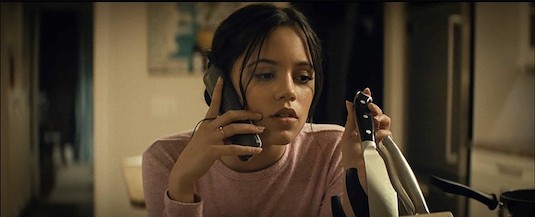Movie Review: Scream (2022)
By Eric Hughes
January 30, 2022
Writer’s note: Light spoilers ahead for both Scream (2022) and the Scream franchise.
There is a gag in the opening moments of Scream (2022) where Jenna Ortega’s character, Tara Carpenter, explains over the phone to Ghostface that her scary movie preference isn’t in slasher films but in “elevated horror”. The concrete examples of elevated horror she then provides to Ghostface include recent films like Hereditary, The Witch and The Babadook. Her character distinguishes between these two classifications – slasher films and elevated horror - as if they are two different sub genres within horror without any overlap.
After 26 years and five films, including the latest one, I’d argue that Tara’s classifications may be correct in her world, but not in ours. This is because the Scream franchise - a series of slasher films, of course - has elevated not only the slasher but the entire horror genre in ways that still seem so overlooked to me:
—Its characters evolve and change within one linear timeline, including its villains, which are never the same
—It explains the conventional rules of the horror film (Scream [1996]), then the horror sequel (Scream 2), then the horror trilogy (Scream 3), and so on, and then demonstrates those rules to us by having them materially play out in each movie
—The series has managed to stay relevant and arguably fresh after each new release through reinvention, something many other franchises - not just horror - often fail to do
The slasher also has another thing going for it, thanks in large part to Scream. It has the power to transcend from popcorn flick to literal art when it holds up a metaphorical mirror and reflects back truths about the culture of the time period the movie shares with its audience. Like a vessel the filmmaker or production team can use to carry societal messages forward.
Scream, in concept, has perfected this process by conforming its villains to the same basic principles:
—Unknown assailants assume the mantle of Ghostface and wreak havoc, mainly on citizens of the fictional Woodsboro, California
—They communicate to their victims and play horror movie trivia games with them through a telephone
—Their weapons of choice are knives; and
—Unconventional to most horror movie villains, they run
Whereas Ghostface’s motivations for murdering people changes with each new installment without feeling contrived, because the character behind the mask chages - another notable contribution from Scream for the genre - the final girl is always the same: Sidney Prescott (Neve Campbell), who finds the means within herself to overcome the odds and beat back the threat of Ghostface.
After the final unmasking in the closing minutes, the persons who gallivanted as Ghostface plainly describe their motivations for raising terror to the remaining characters. In its earliest iterations, still years before the real horror of the Columbine murders, Scream pointed an exasperated, blazing-red arrow at uncontrollable teenage aggression and psychopathy. A decade ago, in Scream 4, the series explored the vanity of social media and pitfalls of celebrity. This time around, without giving too much away, the franchise expounds upon Scream 4’s themes by doing a deeper dive into internet culture’s dark side. Once more, 26 years on, it’s Scream licking its finger, pointing it to the sky, and describing for us the direction and force of the air swirling above our heads.
Continued:
1
2
|
|
|
|




